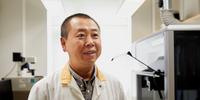
Molecular and Cellular Biology
Molecular and cellular biology research studies molecules and cells in order to improve human health and the environment. Our research groups have many fruitful interdisciplinary interactions with chemists, bioinformaticians, clinicians and biomedical companies and are at the heart of life sciences at the University of Gothenburg.
Key target areas
- Aging
- Cancer
- Glycobiology
- Infections
- Metabolic, developmental and neurodegenerative diseases and disorders such as diabetes and Alzheimer’s disease
- Pollution.
Key research areas
- Antibiotic resistance
- Cytoskeletal dynamics
- Metal biology
- Microbial signalling and communities
- Molecular evolution
- Protein quality control
- Regulation of metabolism
- Stress resistance.
Our researchers combine genetic and molecular tools, e.g. genetic engineering and screening, with computational approaches such as bioinformatics and systems biology, to understand yeast, bacterial, worm, mouse and human cells. They use different biological model systems, robotics to record properties of many cells simultaneously, as well as computational techniques to analyze, integrate and understand large-scale cell and molecular data.
Publications, research grants and collaborations
Our research in Molecular and Cellular Biology is of excellent quality. Our researchers publish scientific papers in top-rated scientific journals such as Nature, Science and Cell. They have also long-term national and international collaborations with leading researchers around the world.
Research groups
Anders Blomberg, Professor Emeritus of Functional Genomics
Anders Blomberg studies how in particular marine organisms handle stress, drugs and polluting chemicals.
Models: yeast, barnacle.
Daniel Bojar, Senior Lecturer in Bioinformatics
Complex carbohydrates or glycans cover every cellular surface and most proteins. Using machine learning and synthetic biology, we can unravel their functions in biology and leverage them for biomedical interventions.
Models: human cells.

Peter Carlsson, Professor of Genetics
Peter Carlsson studies how a class of regulatory proteins control gene expression in embryonic development, cellular differentiation and disease using mouse genetics and in vitro methods.
Models: mouse, human cells.
Read more
Leonardo de Assis, Associate Senior Lecturer in Molecular Medicine
Leonardo de Assis' research explores how skin physiology changes across the day and how intra-tissue cellular communication is important for skin health. He aims to uncover the importance of skin circadian rhythms in physiological and pathological conditions.
Models: mouse, human cells.
Read more
- About Leonardo de Assis
Anne Farewell, Professor of Molecular Microbiology
Anne Farewell studies how antibiotic resistance genes spread between bacteria and aims to develop ways to prevent this. This will extend the usefulness of our antibiotics. Anne also works to improve science teaching.
Models: bacteria.
Read more

Julie Grantham, Professor of Mammalian Cell Biology
The molecular chaperone CCT and the cytoskeleton: understanding the interplay between the folding of actin and tubulin by the CCT oligomer and the role of CCT in modulated processes involving assembled microtubules and actin filaments.
Models: human cells.

Beidong Liu, Professor of Molecular and Cellular biology
Developing and applying yeast (Saccharomyces cerevisiae) high throughput phenomic screening approaches for deciphering mechanisms underlying how protein aggregates influence cellular ageing and stress response.
Models: yeast.
Read more

Anders Lundgren, Researcher in nanobiotechnology
Anders Lundgren studies how cells, bacteria and particles bind to and organize on surfaces. Anders develops methods to measure weak cellular interactions and for the assembly of biofunctional, for example antibacterial, interfaces.
Read more
Margit Mahlapuu, Professor of Molecular Genetics
Margit Mahlapuu's main focus is to elucidate the molecular mechanisms regulating lipid partitioning, inflammatory infiltration and insulin sensitivity in the liver, and cross-talk between the liver and other peripheral tissues prone to lipotoxicity.
Models: mouse, human cells.

Marc Pilon, Professor of Genetics
Genetic mechanisms that regulate cell membrane composition in response to dietary or environmental challenges.
Models: worm, mouse and human cells.
Read more
Åsa Sjöling, Professor of Prokaryotic Microbiology
Åsa Sjöling studies how enterotoxigenic E. coli (ETEC) regulate virulence and survival in response to gastrointestinal- and environmental factors, and how antibiotic resistance genes spread within bacterial populations.
Models: bacterial cells.

Per Sunnerhagen, Professor of Eukaryotic Molecular Biology
Adaptation to stress changes expression and localization of RNA, and may cause stress granules to form. These in turn affect gene expression and cell signaling. In cancer cells, they may change the response to therapy.
Antimicrobial resistance in bacteria and Plasmodium is a threat to treatment of infectious diseases. Novel antimicrobial molecules with novel mechanisms of action are sought.
Models: yeast, bacteria.
Read more
Markus Tamas, Professor of Eukaryotic Microbiology
Molecular and cellular biology of metal toxicity and tolerance. Front-line tools in molecular biology, biochemistry, microbiology and functional genomics are used to gain insights into metal action and cellular tolerance mechanisms.
Models: yeast.

Kaisa Thorell, Associate Senior Lecturer in Infection Biology
The bacterium Helicobacter pylori is an important risk factor for gastric cancer. We study bacterial genomics and microbial diversity focusing on factors that may affect the host-microbe interaction in gastric carcinogenesis.
Models: Bacteria and human cells.

Jonas Warringer, Senior Lecturer in Molecular Evolution
Molecules in tumorous and infectious cells change over time often causing treatments to fail. Understanding and addressing molecular evolution may reduce treatment resistance in cells and improve human health.
Models: yeast, bacteria.
Read more
Research för sustainable development
Our research in Molecular and Cellular Biology contributes to sustainable development in many different ways. Among others, we work with
Health and well-Being
Our researchers seek to discover new targets and strategies for addressing
- Aging
- Bacterial infections and antibiotics resistance
- Cancer
- Developmental diseases
- Heritable (genetic) diseases
- Malaria
- Metabolic diseases, including Diabetes, and fatty liver
- Neurodegenerative diseases, including Alzheimer.